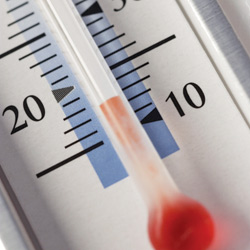Induced Hypothermia

The Midwest and much of the country has been besieged by a bitter cold winter this year. Though not exactly what most would consider desirable, cold temperatures, and more specifically, hypothermia, have played an interesting role in healthcare.
If you’re one of the 300,000 people stricken with a heart attack each year, there is another tool in the arsenal to help prevent bodily damage and possible death. Patients who have out-of-hospital cardiac arrest historically have had a high mortality and morbidity rate. More than 90 percent of these patients die before even reaching the hospital. But a growing list of hospitals offer the potential for cooling therapy as a means of reducing brain damage and increasing the chances of survival for those suffering from sudden cardiac arrest.
As medical procedures go, therapeutic hypothermia, as it is called, is among the simplest: chill the body and wait 24 hours before slowly re-warming the patient. It is the only treatment recognized to protect the brain after a cardiac arrest. Recovery correlates with body temperature: the higher the body temperature after cardiac arrest, the less chance of neurological recovery. Conversely, the lower the temperature, the better chance of neurological recovery.
The use of therapeutic hypothermia is not a new concept. Hippocrates, the father of western medicine, noted the benefits of hypothermia in treating injuries. Napoleon’s surgeons noted that wounded soldiers who were further from the fire had a higher survival rate than those who stayed close. In the 1950s, studies showed that induced hypothermia after cardiac arrest in humans improved survival rates.
Clinicians began seriously exploring the medical use of induced hypothermia in the 1930s, when published cases cited favorable outcomes in patients resuscitated after long periods of apnea following cold-water drowning. Within the last decade, therapeutic hypothermia again caught the interest of physicians and healthcare providers. Research shows that patients who regain a pulse quickly after cardiac arrest may suffer injuries from blood flow resuming too quickly to the brain, often resulting in brain death or severe brain injury.
“Treatment is performed by placing special gel pads over about 40 percent of the body, inserting a temperature probe and selecting the prescribed target temperature,” said Brad Robinson, nurse manager for Cardio-Vascular Intensive Care at Methodist. “The system is designed to mimic water immersion, which is said to be the most effective means of quickly decreasing core body temperature.”
“Good neurological outcomes are very important in resuscitating people from sudden cardiac death,” added Jeanine Spain, vice president for Patient Services. “Induced hypothermia fits into the whole treatment package, in that we’re not just thinking about resuscitating the heart, we’re thinking about the best neurological outcome.”
Induced hypothermia is yet another treatment option in the fight against heart disease. Methodist comprehensive cardiovascular services include advanced diagnostic services, minimally invasive procedures and the area’s longest continuously running open heart surgery program. iBi

